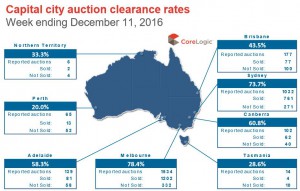National Australia Bank (NAB) this week released the results of their monthly business survey which showed business conditions softened over the month, continuing a trend that has been evident since July 2016.
The business conditions index was down 2 points over the month to a reading of +5.3 after recording a recent high of +12 in June earlier this year.
Despite the weakening trend, according to the NAB survey, business conditions remain stronger than the long term average of +4.8.
The business confidence index nudged higher over the month to +5 (from +4.3 last month) which is slightly lower than the long term average.
Westpac released the results from their December consumer sentiment survey this week which showed a 3.9% decline over the month to be recorded at 97.3, which is the lowest sentiment reading since April earlier this year.
A reading of 100 on Westpac’s index indicates that pessimists and optimists are equally weighted. At 97.3, Australian consumers have become more pessimistic which is probably related to the prospect of rising interest rates, concerns around the Australian economy and soft labour market conditions.
Consumer sentiment has a strong correlation with housing transactions.
If consumer sentiment continues to trend lower it may translate to fewer dwelling sales.
The Australian Bureau of Statistics (ABS) released overseas arrivals and departures data for October which showed further strength in tourist numbers coming to Australia.
Over the past twelve months tourist arrivals are up 12.7% and departures are up only 4.3% in comparison.
Tourists from China are showing the strongest growth, increasing by more than 20% over the past twelve months.
Clearly the lower Australian dollar is having a positive impact, with US tourist numbers also showing a strong rise over the year.
With 3,42 auctions held last week, it was the second busiest auction week of the year (the busiest week of 2016 was the seven days ending March 20).
Even though auctions volumes were close to record highs for the year, the clearance rate held above 70% across the combined capital cities.
Melbourne maintained its position as the largest auction market, with 1,534 auctions last week and a clearance rate of 78.4%. Sydney also maintained a high success rate, with 73.7% of auctions selling over the week.
The coming weeks will see auction activity fall sharply, and auction markets are likely to remain quiet until late the first week of February when activity will start to warm up again.
Note that sales listings are based on a rolling 28 day count of unique properties that have been advertised for sale
Both new and total listing numbers have started their seasonal downturn, with the number of newly advertised properties peaking over the first week of November and total listing numbers peaking two weeks later.
Despite the seasonal slowdown, new listing numbers remain 10.7% higher than a year ago nationally and 9.4% higher across the capital cities.
Every capital city is now showing new listing numbers to be higher than at the same time last year which is in stark contrast to the spring season when new listing numbers were generally tracking lower than a year ago.
CoreLogic is currently tracking just over 240,000 properties that are being advertised for sale nationally.
Interestingly, total advertised stock levels remain lower than a year ago in the markets where dwelling values are rising the fastest (Sydney, Melbourne, Canberra and Hobart); a trend that suggests that low stock levels are contributing to the upwards pressure on housing prices in these cities.


No comments:
Post a Comment